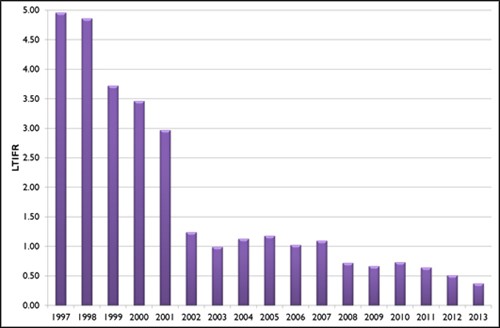Proceedings of the 20-21 September 2012 OSHA Workshop on the Future of Drilling Regulations
The International Marine Contractors Association (IMCA) has produced two important sets of statistics – ‘Safety and environment statistics for IMCA members: Report for the period 1 January-31 December 2013‘ and ‘World-wide diving personnel statistics for IMCA members: Statistics for 2012‘.
“Safety and environment statistics are a useful insight into the performance of a company and industry sector in the areas of health, safety and environment,” explains IMCA’s Technical Director, Jane Bugler.”And our diving statistic aim to give a global snapshot of how many people are active in the industry on three specific dates in the year.”
“The purpose of our safety and environment statistics, produced on an annual basis and covering fatalities, injuries and environmental indicators supplied by contractor members, is to record the safety and environment performance each year, and to enable IMCA members to benchmark their performances. This year a record number of companies took part in the survey which is based on over 1300 million man-hours of work overall.
“Encouragingly we have seen lost time injury frequency rates (LTIFR) drop to the lowest figure since we began collecting data. However, there is still room for improvement in our constant quest for the ‘holy grail’ of zero incidents.
Getting down to details
“The main injury/incident figures continue to ‘flatline’ or improve only slowly,” she explains.”I am glad to report that there were fewer fatalities (9) in 2013 than in 2012 (14). Lost time incidents (LTIs) remain broadly constant.
“The highest number of LTI’s was caused by being struck by moving/falling objects (23%), falls on the same level (including slips and trips) accounted for 20% of LTIs; ‘struck against’ for 13%; falls from height 10%; muscle stress and repetitive movement accounted for 5%; entrapment for 4%, contact/exposure to heat/cold 2%; and both contact/exposure with hazardous substance and contact with electricity accounted for 1% of LTIs. Unfortunately there has been an increase in the number of LTIs reported without an immediate cause, which accounted for 21% of incidents, we will be urging our members to give more detail in future years. All facts and figures we receive are anonymised”
The statistics for 2013 were provided by a record number of 245 companies and organisations, representing around 67% of the contractor membership. Fifty-nine contractors took part for the first time, but 35 contractors that took part in the 2012 exercise did not do so this year; the number of very large contractors (more than 30,000 employees based on man-hours) taking part continues to increase, from one last year, to four this year.
The 2013 dataset is based upon 1301 million man-hours of work overall (1008 million man-hours offshore) – again a record. Onshore data was provided by 191 of the 245 companies (78%); and environmental data was provided by 47% of members. IMCA uses one million, rather than 200,000 man-hours, as a basis for the calculation of lost time injury frequency rate (LTIFR) and total recordable injury frequency rate (TRIR). The offshore LTIFR for 2013 has improved to 0.35 from 0.57 in 2012, and the overall LTIFR has improved from 0.51 in 2012 to 0.37 this year – both figures are the lowest since IMCA began collecting data.
“The safety statistics recorded by IMCA members are consistent with those of other main global industry associations the International Association of oil & Gas Producers (OGP) and the International Association of Drilling Contractors (IADC),” explains Jane Bugler.
Environmental data
This is the second year that IMCA has collected information from contractor members on their environmental performance. The information sought has been broadly based on IMCA SEL 010 – Guidelines for the use of environmental performance indicators, so covers: number of spills and amount spilt; bunkers used (by volume or by weight); electricity consumed onshore; and non-hazardous and hazardous waste generated.
“As this is only the second year in which we have collected environmental data it is difficult to identify any trends,” explains Jane Bugler.”We have now established a firm foundation for future years and will then be able to plot specific trends.”
Diving statistics
With the exception of a two-year gap in the mid-nineties, diving and ROV personnel statistics for the North Sea area (Denmark, the Netherlands, Norway and the UK) were collected and published annually between 1982 and 2008.
Although it was appreciated the figures only present a ‘snapshot’ as they relate, in the case of diving, to three dates in the year (1 May, 1 July and 1 September), they were nevertheless highly indicative when looking at trends and other factors. In 2009 IMCA extended the statistics to cover the entire world. This therefore is the fourth year in which this world-wide approach has been taken and it has become possible to observe changes.
Over the three year period 2009 to 2011 (inclusive) the total reported average number of people at work (supervisors/superintendents, saturation divers, air divers, life support technicians, tenders, and all other offshore diving support personnel) was 3539. In 2012 the total reported average number of people at work in the global diving industry was 2736 (peaking at 2781). This figure represents just under a 23% reduction between the 2012 figure and the average of the three previous years.
“This apparent sudden decrease may well not be a true representation of the situation offshore,” explains Jane Bugler.”It may simply be a consequence of the relatively low number of returns from contractor members of the IMCA Diving Division in 2012. We received information from just 34 diving contractor members for 2012 which in itself represents a 17% reduction in the number of members providing information compared to the average returns for 2009-2011. Nevertheless we believe that the major players in the offshore diving industry contributed to the 2012 data gathering exercise..
“If we take the data collected at face value, it would appear that, with the exception of the South American region, between 2011 and 2012 the numbers of personnel involved in offshore diving operations for IMCA members has fallen across the board The trend for increasing numbers of saturation divers working world-wide has gone into reverse and shows a sharp overall decline in 2012. Air diving numbers are slightly up on 2011.
“Regionally we see that in our Asia-Pacific region overall diving activity continues to decline and is now approximately a third of what it was in May 2009. In our Europe & Africa region diving activity has dropped back but not too markedly; diving activity in Central & North America has seen the steepest decline of any region in 2012 – the data indicates it is about 30% of the level reported in September 2009. Overall offshore diving activity in the Middle East & India has dropped back to 2010 levels, but the number of saturation divers in this region has increased by nearly 35%; and lastly when looking at South America we see that overall diving activity has risen tremendously (from a mean of just 19 offshore diving personnel in 2011 to a mean of 295 in 2012 – but the figures may be skewed by the inclusion, for the first time, of data from a major contractor member working in Brazil).”
Fuller information
Both sets of statistics are made available to IMCA members globally as information notes


IMCA Contact
Nicholas Hough
Consultant - Safety and Security
Contact
Information Note Details
Published date: 16 October 2012
Information note ID: 1141
IMCA’s store terms and conditions (https://www.imca-int.com/legal-notices/terms/) apply to all downloads from IMCA’s website, including this document.
IMCA makes every effort to ensure the accuracy and reliability of the data contained in the documents it publishes, but IMCA shall not be liable for any guidance and/or recommendation and/or statement herein contained. The information contained in this document does not fulfil or replace any individual’s or Member's legal, regulatory or other duties or obligations in respect of their operations. Individuals and Members remain solely responsible for the safe, lawful and proper conduct of their operations.
